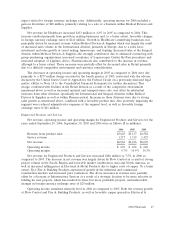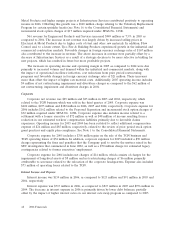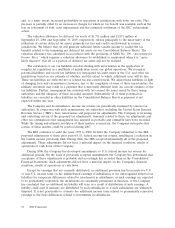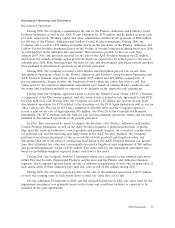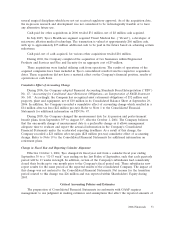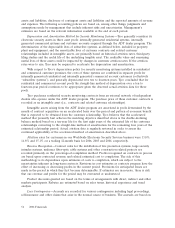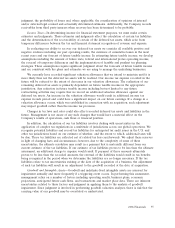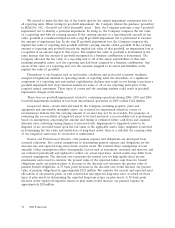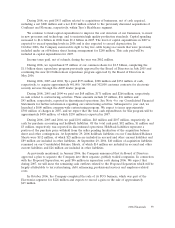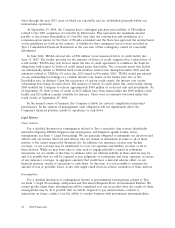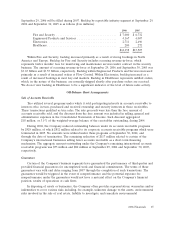ADT 2006 Annual Report Download - page 117
Download and view the complete annual report
Please find page 117 of the 2006 ADT annual report below. You can navigate through the pages in the report by either clicking on the pages listed below, or by using the keyword search tool below to find specific information within the annual report.judgment, the probability of losses and, where applicable, the consideration of opinions of internal
and/or external legal counsel and actuarially determined estimates. Additionally, the Company records
receivables from third party insurers when recovery has been determined to be probable.
Income Taxes—In determining income for financial statement purposes, we must make certain
estimates and judgments. These estimates and judgments affect the calculation of certain tax liabilities
and the determination of the recoverability of certain of the deferred tax assets, which arise from
temporary differences between the tax and financial statement recognition of revenue and expense.
In evaluating our ability to recover our deferred tax assets we consider all available positive and
negative evidence including our past operating results, the existence of cumulative losses in the most
recent years and our forecast of future taxable income. In estimating future taxable income, we develop
assumptions including the amount of future state, federal and international pretax operating income,
the reversal of temporary differences and the implementation of feasible and prudent tax planning
strategies. These assumptions require significant judgment about the forecasts of future taxable income
and are consistent with the plans and estimates we are using to manage the underlying businesses.
We currently have recorded significant valuation allowances that we intend to maintain until it is
more likely than not the deferred tax assets will be realized. Our income tax expense recorded in the
future will be reduced to the extent of decreases in our valuation allowances. The realization of our
remaining deferred tax assets is primarily dependent on future taxable income in the appropriate
jurisdiction. Any reduction in future taxable income including but not limited to any future
restructuring activities may require that we record an additional valuation allowance against our
deferred tax assets. An increase in the valuation allowance would result in additional income tax
expense in such period and could have a significant impact on our future earnings. If a change in a
valuation allowance occurs, which was established in connection with an acquisition, such adjustment
may impact goodwill rather than the income tax provision.
Changes in tax laws and rates could also affect recorded deferred tax assets and liabilities in the
future. Management is not aware of any such changes that would have a material effect on the
Company’s results of operations, cash flows or financial position.
In addition, the calculation of our tax liabilities involves dealing with uncertainties in the
application of complex tax regulations in a multitude of jurisdictions across our global operations. We
recognize potential liabilities and record tax liabilities for anticipated tax audit issues in the U.S. and
other tax jurisdictions based on our estimate of whether, and the extent to which, additional taxes will
be due. These tax liabilities are reflected net of related tax loss carryforwards. We adjust these reserves
in light of changing facts and circumstances; however, due to the complexity of some of these
uncertainties, the ultimate resolution may result in a payment that is materially different from our
current estimate of the tax liabilities. If our estimate of tax liabilities proves to be less than the ultimate
assessment, an additional charge to expense would result. If payment of these amounts ultimately
proves to be less than the recorded amounts, the reversal of the liabilities would result in tax benefits
being recognized in the period when we determine the liabilities are no longer necessary. If the tax
liabilities relate to tax uncertainties existing at the date of the acquisition of a business, the adjustment
of such tax liabilities will result in an adjustment to the goodwill recorded at the date of acquisition.
Goodwill and Intangible Assets—Goodwill and indefinite-lived intangible assets are assessed for
impairment annually and more frequently if a triggering event occurs. In performing this assessment,
management relies on a number of factors including operating results, business plans, economic
projections, anticipated future cash flows, and transactions and market place data. There are inherent
uncertainties related to these factors and judgment in applying them to the analysis of goodwill
impairment. Since judgment is involved in performing goodwill valuation analyses, there is risk that the
carrying value of our goodwill may be overstated or understated.
2006 Financials 55




